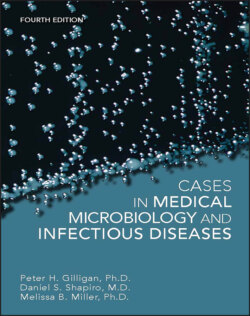Читать книгу Cases in Medical Microbiology and Infectious Diseases - Melissa B. Miller - Страница 29
Media
ОглавлениеThe selection of media to be used in isolation of pathogens from clinical specimens is dependent on several factors. First, the nutritional requirements of the specific pathogen must be met. For example, fastidious organisms require a medium that is enriched with specific nutrients, such as animal blood, serum, or other growth factors. If the clinical specimen is obtained from a site that has a resident microbiota, certain strategies will be necessary to isolate a specific pathogen from the accompanying resident microbiota. Often in this setting, a special type of medium called selective medium is used to recover these pathogens. This medium selects for the growth of a specific group of organisms. This is done by adding substances, such as dyes, antibiotics, or bile salts, that inhibit the growth of one group of organisms while permitting the growth of another. For example, MacConkey agar is a selective medium that contains bile salts and the dye crystal violet. These two substances are inhibitory for Gram-positive organisms as well as some Gram-negative ones. A wide variety of Gram-negative rods grow on this medium. Some selective media are also differential. MacConkey agar is an example of a selective and differential medium. The Gram-negative bacilli that grow on this agar can be differentiated from one another on the basis of the organism’s ability to ferment the carbohydrate lactose. Organisms that ferment lactose are called lactose positive, and organisms that are unable to ferment lactose are called lactose negative (Fig. 10). When selecting media for culturing clinical specimens from sites with a resident microbiota, typically both enriched and selective media are used. If Gram-negative bacilli are a component of this microbiota, than a selective-differential medium might be used as well.
Figure 10
Certain organisms will not grow on media commonly used to culture clinical specimens, because the media may not be enriched enough or may contain inhibitory substances. When these organisms are sought, the laboratory must be notified so that special isolation medium can be used. Two important respiratory tract pathogens, B. pertussis and L. pneumophila, are examples of organisms that do not grow on standard laboratory media and require special media for their isolation.
